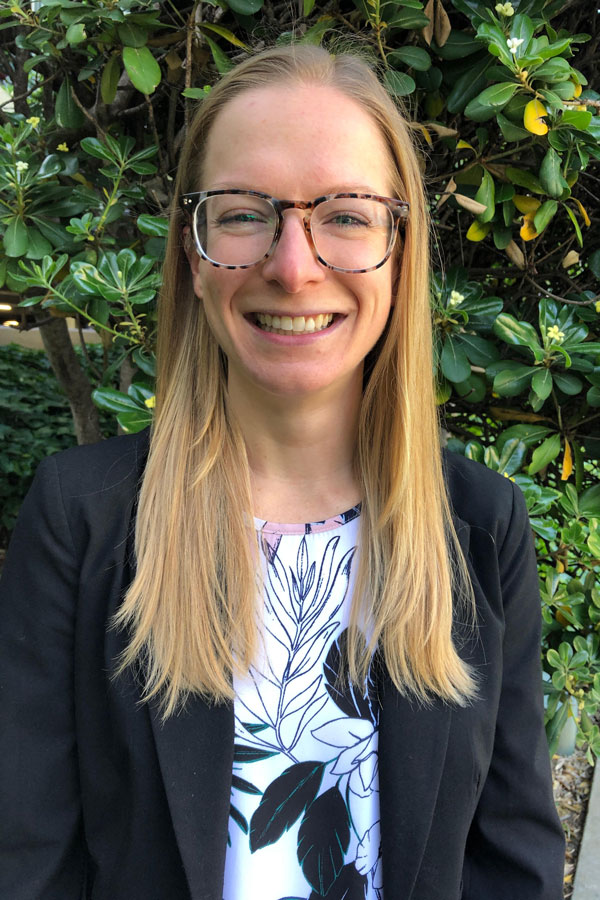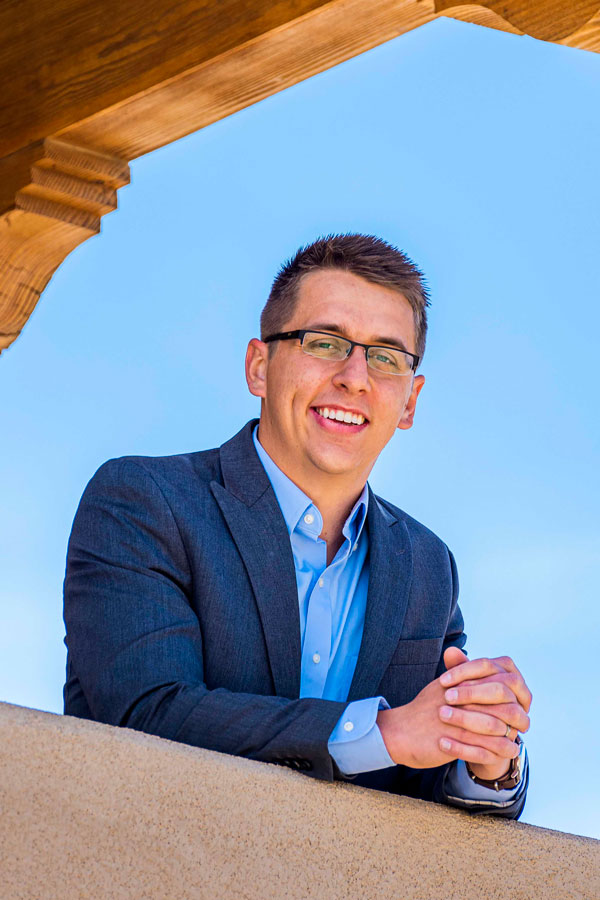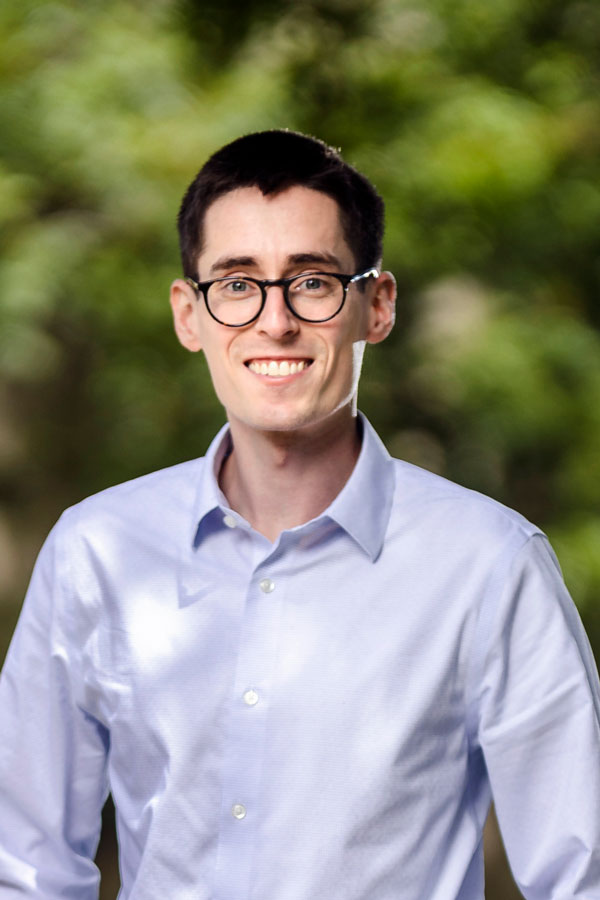Bette Webster, Nils Otterstrom and Aaron Sharpe talk about their research careers and Sandia
A trio of postdoctoral fellows joined Sandia last September to conduct their research in support of the Labs’ national-security mission.
Elizabeth “Bette” Webster was awarded a Jill Hruby Fellowship, named for the first woman to direct a U.S. national security laboratory and President Biden’s nominee as the next NNSA administrator. Nils Otterstrom and Aaron Sharpe received Harry S. Truman Fellowships and are conducting their work through the Laboratory Directed Research and Development program.
Lab News spoke to each fellow about the work they plan to conduct over the next three years.
Elizabeth “Bette” Webster: On the frontlines of the virologic war

While at Stanford University, Bette focused her doctoral research on viral membrane platforms and host-pathogen interactions. She is continuing her work in biotechnology and bioengineering.
Lab News: Did the COVID-19 pandemic amplify the need for any specific aspect of your research?
Bette Webster: The pandemic highlighted the need to better understand emerging viral threats. My fellowship research develops model membrane platforms to characterize enveloped virus entry and membrane-based delivery systems. Fundamental studies help us gain a better understanding of membrane entry mechanisms, which then can be used in technologies to address future viral threats.
LN: Viruses and bacteria are difficult to treat because they reside in intracellular membrane compartments. How does developing membrane platforms assist you in examining host-pathogen interactions?
BW: To successfully infect a host, an enveloped virus must fuse its membrane with that of the cell. This process of membrane fusion is highly conserved, presenting a unique target for combating viral threats. By using model membrane platforms, I can precisely examine how specific factors, e.g., lipid composition and changing pH, play a role in membrane fusion, and also build complexity into the system, e.g., isolating host membrane protein, while limiting the number of variables involved. It’s critical to understand how each piece fits together, and this approach allows me to be very controlled and examine how different membrane factors play a role in virus entry.
LN: How would your work creating biological testing procedures align with nanoparticle delivery and detection platforms used in vaccines?
BW: Nanoparticles help navigate various biological barriers that are heterogeneous across patient populations and diseases. Some of the current vaccines for COVID-19 are lipid nanoparticle technologies which demonstrates their utility as a delivery mechanism. My membrane platforms could help identify a fundamental approach for characterizing these systems and improving lipid-based delivery systems, which could lead to development of novel nanoparticle applications.
LN: Stanford encourages creative thinking, interdisciplinary collaboration and high-stakes, high-reward research. Sandia’s LDRD Mission Campaigns and Grand Challenges operate in a similar fashion. How did your PhD experience prepare you for larger, cooperative research projects?
BW: At Stanford, I was part of the Chemistry, Engineering, and Medicine for Human Health (ChEM-H) Program. While my doctorate is in Chemistry, my research intersects many areas including virology, surface science and membrane biophysics. The ChEM-H Program was instrumental in developing collaborative networks, troubleshooting technical difficulties in the lab and developing new ways of asking questions. That interdisciplinary environment broadened my knowledge beyond my own field and challenged me to clearly communicate with others whose specialties differ from my own.
LN: What motivated you to pursue a career in research?
BW: My scientific mentors helped me understand that the impact you have on others can be just as important as the scientific findings. At the University of San Diego, my undergraduate research mentor, Prof. Lauren Benz, provided scientific training as well as subtle demonstrations of inclusive teaching and mentorship, practices I continued to refine in graduate school. A career in research allows me to answer interesting scientific questions while creating an inclusive culture and mentoring future generations.
LN: How do opportunities like the Jill Hruby Fellowship motivate early career researchers?
BW: The Jill Hruby Fellowship provides me with the independence to pursue my own ideas and research while gaining valuable insight into Sandia’s structure and research portfolio, which facilitates my leadership development. Being able to contribute toward Sandia’s larger mission is truly exciting.
Nils Otterstrom: Lighting the way to a quantum future through photonics

Nils, an applied physicist who completed his doctorate at Yale, works in photonic microsystems. His focus is on using nonlinear optical processes in integrated photonics for quantum networking, computing and sensing applications.
LN: Quantum computing is a field with seemingly boundless applications. How would your work in this area be a potential game changer?
NO: There are a variety of promising candidate physical systems for quantum computing, including trapped ions, superconducting qubits, photonics and defect centers in crystals. Sandia is a leader in many of these areas. Each one has its own relative advantages and disadvantages. In this context, a tantalizing goal is to create hybrid quantum systems that can synergistically combine the strengths of these disparate platforms and technologies.
My Truman research aims to leverage the unique properties of light to interface and network disparate quantum systems and technologies. Central to this work is the concept of transduction — converting qubits from one state to another. If we’re successful, we’ll be able to leverage and combine the advantages of different quantum systems and necessary technologies that otherwise would be very challenging to bring together.
LN: The introduction of a Science magazine article where you were first author noted, “Silicon is the workhorse of the semiconductor electronics industry.” What experiences drove your interest in silicon?
NO: I began my research career as an undergrad working in an atomic physics lab. The experiments were physically impressive and required an expansive and complex arrangement of optics, lasers and vacuum chambers. As I worked on different optical systems, I became enamored with integrated photonics, where you can, in principle, miniaturize large optical systems, which otherwise could occupy a good part of a large optics table, into compact silicon chips. To do this, we use standard, highly scalable microelectronic fabrication techniques to make tiny silicon photonic waveguides, or wires, that convey light around the chip. In my graduate research at Yale with Peter Rakich, a former Sandian, we harnessed radically enhanced interactions between light and gigahertz-sound waves to make new types of optomechanical-based lasers and optical amplifiers. One of many exciting facets of research in this area is that advances can readily be adapted to scalable technologies since we’re using standard complementary metal-oxide-semiconductor processes.
LN: What outcomes are you hoping for during your time at the Labs?
NO: I had the opportunity to collaborate with Sandia’s microsystems group during my PhD work, and I was impressed by the scope and quality of research in this area. Sandia is a true leader in this field thanks to the Microsystems Engineering Science and Applications program’s advanced foundry-scale manufacturing capabilities and expert scientists and engineers. I hope that my unique research trajectory will have a profound impact on the field and important mission applications.
LN: Sandia’s LDRD program has roots in discovery science and mission application. How does this hybrid approach incentivize early career researchers?
NO: Young researchers are interested in having real impact. At Sandia, we have the chance not only to influence the academic community, but also to make a difference in real-world national security applications. The work here is meaningful on multiple levels.
Aaron Sharpe: Drawn toward superlattices and quantum magnetism

Aaron graduated from Rice University and obtained his doctorate in applied physics from Stanford. He joined Sandia to investigate properties of twisted bilayer graphene and to establish its viability as a cryogenic memory element for classical cryogenic computers.
LN: DOE recently announced they want to fund research toward the development of a quantum internet. Does your discovery in ferromagnetic behavior and work in emergent quantum magnetism and cryogenic spin-memory have implications for such an application?
AS: A particular challenge for a quantum internet based around quantum devices is that they need to be kept extremely cold to function. The prominent technologies for solid state quantum computers are superconducting and semiconductor spin qubits, both of which will likely need to be cooled to below 100 millikelvin in an ultralow temperature cryostat. It’s likely a powerful classical computer will need to interface with the quantum computer and be mounted within the cryostat, so a classical computer will need to be designed to operate at ultralow-temperatures. Very little research has been done into meeting the efficiency requirements for cryogenic memory, and that’s what makes the discovery of ferromagnetism in twisted bilayer graphene such a pleasant surprise. Discovering that graphene, a material composed entirely of carbon, can become magnetic and that the magnetism can be controlled electrically makes it a strong candidate for an extremely low-power cryogenic memory.
LN: How could graphene superlattices be leveraged in quantum systems?
AS: Superlattices are basically the same idea as the strange optical effect you can see when driving under an overpass with chain-link fences on both sides, or why you can’t wear a striped shirt on television. When you have two similar patterns overlapping with a slight shift or rotation — either the two fences or the shirt and pixels of your TV display — you form a moiré pattern: an interference pattern of a much larger length scale. Typically, electrons in graphene travel about and don’t care about each other at all. But by stacking at a very particular relative angle, the electrons now “feel” each other and behave cooperatively to minimize the total energy of the system. This was the key leap leading physicists to discover that graphene can become both a superconductor and a ferromagnet. This tunable platform will hopefully lead to key insights in developing novel quantum devices.
LN: What impact do design competitions such as the DREAM program in which you’ve been involved have on students?
AS: DREAM, a volunteer-based mentorship program, strives to increase the number of underrepresented minority students earning undergraduate degrees in STEM through high school design competitions. Sandia’s Brent Houchens has served as the program’s adviser since its founding in 2006. The DREAM competitions get students talking to the mentors, but once engaged in a small team setting, they talk to the mentors about big questions such as college. Over four years, I mentored many students, and it was rewarding to walk into a huge high school and have those students yell out to me.
LN: What is it about Sandia’s LDRD program that motivates early career researchers to pursue work at a national laboratory?
AS: As a researcher who performs fundamental research, the national laboratories provide the security of assured funding, which allows researchers to go after difficult, high upside questions. My main concern was getting stuck in my own little research island, but there is also a ton of flexibility to seek out other research opportunities at Sandia.